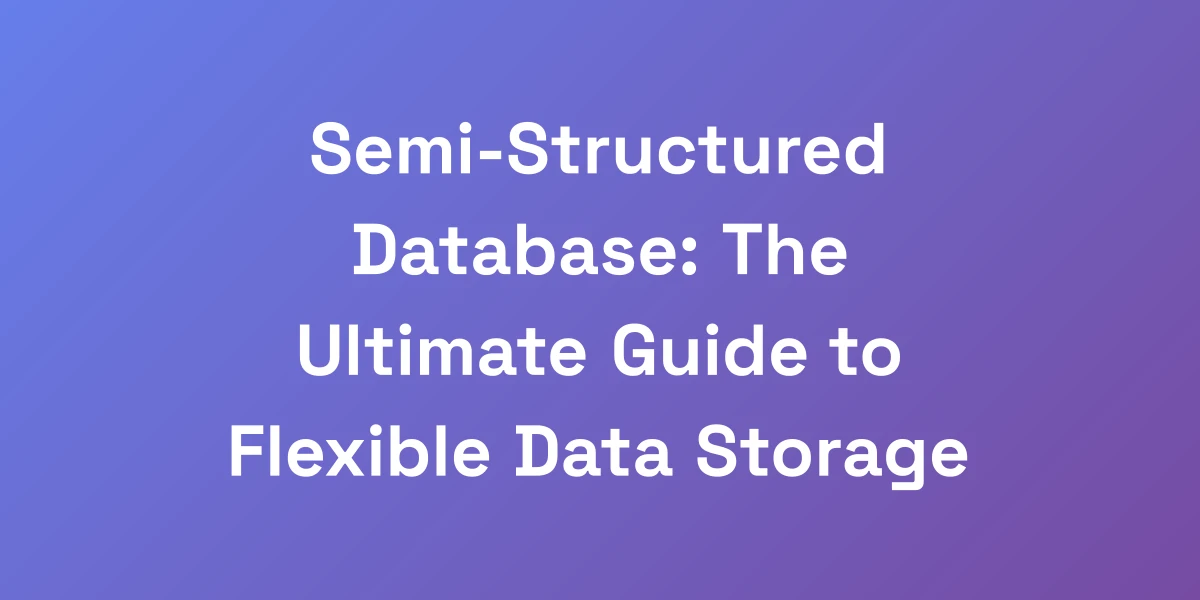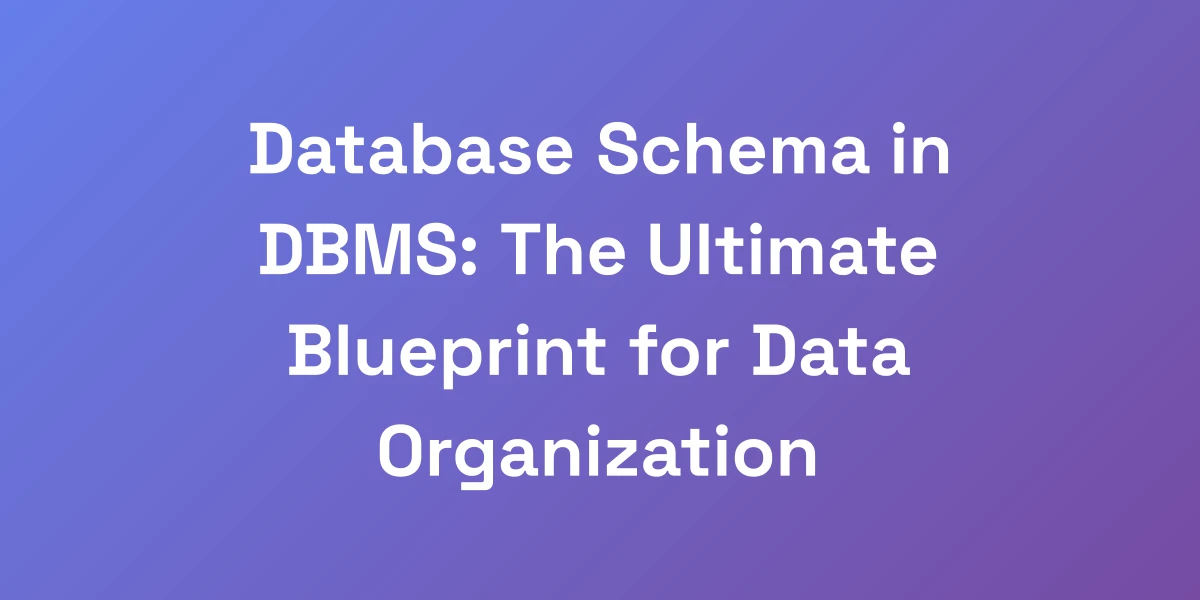
Database Hierarchy: The Ultimate Guide to Tree-Based Data Models
Mar 31, 2025 | By [email protected]
Understanding the Power of Database Hierarchy in Modern Systems
Let us hit you with some truth: most developers overcomplicate their data structures when a simple hierarchical database model would crush it.
Here’s the thing – database hierarchy isn’t just some outdated concept from the mainframe era. It’s a powerful pattern that mirrors how humans naturally organize information.
When we grasp the raw potential of parent-child relationships in data modeling, we’ll realize why tech giants still leverage tree-based models are still branching out in business for specific use cases.
I’m going to show you exactly how to weaponize this knowledge to build systems that scale.
The Core Principles of Hierarchical Data Organization
At its essence, a hierarchical database organizes data in a tree-like structure, much like our own organizational charts or file systems.
Each record, or node, has a single parent and may have multiple children, creating clear and straightforward pathways for data traversal.
This simplicity is its strength. By maintaining a clear parent-child relationship, we ensure data integrity and swift access times.
Consider an inventory management system. Products are categorized under categories, subcategories, and so forth, mirroring the real-world hierarchy.
- Parent-Child Relationships: Each parent node can have multiple child nodes, but each child node has only one parent.
- Data Integrity: The structure enforces a strict hierarchy, reducing data redundancy and maintaining consistency.
- Efficient Retrieval: Navigating through a tree structure allows for fast data access, especially in well-defined hierarchies.
These principles form the backbone of why hierarchical databases remain relevant today.
Evolution from IMS to Modern Implementation
Hierarchical databases have come a long way since their inception with IBM’s Information Management System (IMS) in the 1960s.
Originally designed for mainframe environments, IMS provided a robust framework for managing large volumes of data with strict hierarchical relationships.
But technology doesn’t stand still. Over the decades, we’ve seen hierarchical models evolve to adapt to modern needs.
Today’s implementations often integrate with other database models, offering hierarchical vs relational databases solutions that leverage the strengths of each system.
- Legacy Systems: Many enterprises still rely on IMS for mission-critical applications, highlighting the lasting utility of hierarchical structures.
- Modern Adaptations: Contemporary hierarchical databases support advanced features like scalability and integration with relational and NoSQL databases.
- Hybrid Models: By combining hierarchical structures with other models, we achieve greater flexibility and functionality.
This evolution underscores the adaptability of hierarchical databases, ensuring they remain a viable option in today’s diverse Database Management System market.
Why Tree Structures Still Matter in 2025
Fast forward to 2025, and tree structures are far from obsolete. In fact, they are more relevant than ever.
With the explosion of data and the need for efficient organization, hierarchical models provide a streamlined approach to managing complex datasets.
Tech giants continue to utilize tree structures in areas like file systems, organizational charts, and content management systems.
Why? Because they offer a balance of simplicity and efficiency that other models struggle to match in specific scenarios.
- Scalability: Hierarchical databases can scale effectively for applications where data naturally fits into a tree structure.
- Performance: For read-heavy operations, hierarchical databases deliver rapid data retrieval due to their structured nature.
- Maintainability: The clear organization simplifies maintenance and updates, reducing the likelihood of errors.
In essence, tree structures provide a foundation that supports the growing demands of modern systems without unnecessary complexity, as highlighted by the Database Management Systems (DBMS) market.
Key Components of Database Hierarchy
Understanding the key components of a database hierarchy is crucial for leveraging its full potential.
These components work together to create a robust and efficient data model.
- Nodes: The fundamental building blocks of a hierarchical database. Each node represents a data record.
- Parent Nodes: Nodes that have one or more child nodes. They serve as the entry points in the hierarchy.
- Child Nodes: Nodes that inherit their placement from parent nodes, creating sub-levels within the hierarchy.
- Root Node: The topmost node in the hierarchy, from which all other nodes descend.
- Branches: The pathways that connect parent nodes to child nodes, forming the tree structure.
Each of these components plays a specific role in maintaining the integrity and functionality of the hierarchical database.
The Psychology Behind Hierarchical Organization
Human brains are wired to understand and process hierarchical structures effortlessly.
From organizational charts to family trees, we instinctively comprehend layered relationships.
This natural affinity makes hierarchical databases intuitive and user-friendly.
When data is organized in a familiar tree structure, it reduces cognitive load, allowing users to navigate and comprehend information more efficiently.
- Intuitive Navigation: Users can easily follow the hierarchy, making data retrieval straightforward.
- Enhanced Memory Retention: Information structured hierarchically is easier to remember and recall.
- Logical Organization: Hierarchical models mirror logical relationships, promoting clarity and consistency.
By aligning with our innate cognitive patterns, hierarchical databases facilitate smoother interactions and better user experiences.
Mastering Parent-Child Relationships in Database Design
Listen up – if we’re not leveraging parent-child relationships correctly, we’re leaving serious performance gains on the table.
The secret sauce isn’t just in creating connections – it’s in optimizing these relationships for maximum efficiency.
We’ve seen countless systems fail because developers didn’t understand the fundamental principles of hierarchical data modeling.
Let us break down the exact framework that will transform how we approach database relationships forever.
Designing Efficient Parent-Child Links
Designing efficient parent-child links is the cornerstone of a high-performance hierarchical database.
Our goal is to establish clear, robust connections that facilitate swift data retrieval and maintain integrity.
- Consistent Naming Conventions: Use clear and consistent names for parent and child nodes to avoid confusion and ensure uniformity.
- Indexing: Implement indexing on parent and child identifiers to accelerate query performance.
- Normalization: Ensure that data is normalized to reduce redundancy and enhance consistency across the hierarchy.
By focusing on these aspects, we create a well-organized structure that supports efficient data management and retrieval.
For example, in an organizational database, each department (parent) can have multiple teams (children), all easily accessible through indexed links.
Handling Multiple Children and Single Parents
Managing the balance between multiple children and single parents is crucial for maintaining a scalable and flexible database.
We need strategies to handle complex hierarchies without compromising performance or integrity.
- One-to-Many Relationships: Ensure that each parent can seamlessly connect to multiple children without data conflicts.
- Data Integrity Constraints: Implement constraints to maintain the single-parent rule, preventing data anomalies.
- Efficient Query Design: Design queries that can handle multiple child nodes efficiently, avoiding performance bottlenecks.
Consider a content management system where a single category (parent) can have numerous articles (children). Properly managing these relationships ensures smooth content organization and retrieval.
Optimization Techniques for Deep Hierarchies
Deep hierarchies can pose challenges, but with the right optimization techniques, we can maintain performance and manageability.
- Lazy Loading: Load child nodes only when needed to reduce initial load times and enhance performance.
- Caching: Implement caching strategies to store frequently accessed nodes, minimizing database hits and speeding up access.
- Denormalization: In some cases, denormalizing parts of the hierarchy can improve read performance by reducing the number of joins required.
For instance, a file system with deeply nested directories can benefit from caching frequently accessed folders, ensuring quick access without traversing the entire path every time.
Managing Hierarchical Data Integrity
Maintaining data integrity in a hierarchical database is non-negotiable. It ensures that the data remains accurate, consistent, and reliable.
- Referential Integrity: Ensure that every child node accurately references its parent, preventing orphaned records.
- Validation Rules: Implement validation rules to enforce business logic and data consistency across the hierarchy.
- Transaction Management: Use transactional operations to maintain data integrity during updates, inserts, and deletions.
For example, in an inventory system, ensuring that every item is linked to a valid category prevents data discrepancies and enhances the reliability of the system.
Advanced Tree Traversal Strategies
Efficient tree traversal is essential for optimizing data retrieval and manipulation in hierarchical databases.
- Depth-First Search (DFS):strong> Explores as far down a branch as possible before backtracking, ideal for scenarios where we need to process all nodes in a subtree.
- Breadth-First Search (BFS):strong> Explores all nodes at the current depth before moving to the next level, useful for level-order processing and finding the shortest path.
- Recursive Queries: Utilize recursive queries to navigate through multiple levels of the hierarchy without excessive complexity.
Implementing these traversal strategies allows us to efficiently navigate and manipulate large and complex hierarchical structures, ensuring optimal performance and scalability.
Real-World Applications That Crush It With Hierarchical Models
Stop theorizing and start implementing. The real money is in knowing exactly where hierarchical databases demolish traditional models.
We’re talking about systems that handle millions of records while maintaining lightning-fast access times.
From file systems to organizational structures, we’re going to show you the precise scenarios where hierarchical databases aren’t just good – they’re absolutely unbeatable.
These are the same patterns that power some of the most successful tech products today.
Enterprise Organization Systems
In large enterprises, organizing departments, teams, and roles in a hierarchical manner provides clarity and efficiency.
- Clear Structure: Hierarchical databases mirror the organizational chart, making it easy to manage and navigate.
- Efficient Resource Allocation: Quickly identify and allocate resources based on the hierarchical relationships.
- Scalability: Easily add new departments or teams without disrupting the existing structure.
For example, a multinational corporation can manage its global offices, regional teams, and local branches seamlessly using a hierarchical database, ensuring smooth operations and strategic oversight.
File System Implementation
File systems are quintessential examples of hierarchical models in action.
- Organized Storage: Files are neatly organized into folders and subfolders, enhancing findability and management.
- Access Control: Hierarchical permissions ensure that only authorized users can access specific directories or files.
- Efficient Navigation: Users can navigate the file system intuitively, much like browsing through a physical filing cabinet.
Operating systems like Windows and macOS rely on hierarchical file systems to provide users with an intuitive and efficient way to manage their files, demonstrating the model’s enduring utility.
Content Management Systems
Content management systems (CMS) like WordPress and Drupal utilize hierarchical models to manage content effectively.
- Category Hierarchies: Organize content into categories and subcategories, making it easier for users to find relevant information.
- Navigation Menus: Create structured navigation menus that reflect the content’s hierarchy, improving user experience.
- Content Relationships: Manage relationships between different content types, such as posts, pages, and media.
By using a hierarchical structure, CMS platforms ensure that content is organized logically, enhancing both management and user accessibility.
Product Categorization
In e-commerce, product categorization is vital for both the user experience and backend management.
- Intuitive Browsing: Customers can browse products by categories and subcategories, finding what they need with ease.
- Inventory Management: Assign products to specific categories, simplifying inventory tracking and management.
- SEO Benefits: Well-structured categories improve search engine rankings by providing clear pathways for crawlers.
Online retailers like Amazon leverage hierarchical categorization to organize millions of products, ensuring that users can effortlessly navigate and find items.
Geographic Data Organization
Managing geographic data involves complex relationships that are well-suited to hierarchical models.
- Region Hierarchies: Organize data by regions, countries, states, and cities, providing a clear geographical structure.
- Data Aggregation: Aggregate data at various levels, such as regional sales or national statistics.
- Spatial Queries: Perform efficient spatial queries by navigating the hierarchical structure.
Applications like GIS (Geographic Information Systems) use hierarchical models to manage and analyze spatial data, enabling efficient processing and visualization of geographic information.
Overcoming Traditional Limitations of Hierarchical Databases
Here’s the brutal truth: hierarchical databases have limitations.
But what separates the pros from the amateurs is knowing how to turn these constraints into advantages.
We’ve developed specific strategies that transform the rigid nature of hierarchical structures into a foundation for building unstoppable systems.
Let us show you the exact blueprint for overcoming every major challenge while maintaining the core benefits of the hierarchical model.
Modern Solutions for Data Redundancy
Data redundancy can be a significant issue in hierarchical databases, leading to inefficient storage and potential inconsistencies.
- Normalization: Apply normalization principles to minimize data duplication and ensure consistency across the hierarchy.
- Shared Nodes: Use shared nodes where applicable to reduce redundancy and streamline data management.
- Data Deduplication Tools: Implement tools that automatically identify and eliminate duplicate data, maintaining a clean and efficient database.
For example, in a product categorization system, shared attributes across categories can be managed through normalization, reducing redundancy and enhancing data integrity.
Handling Complex Relationships
Hierarchical databases can struggle with complex relationships that don’t fit neatly into a tree structure.
- Hybrid Models: Combine hierarchical databases with relational or NoSQL systems to manage complex relationships seamlessly.
- Link Tables: Use link tables to represent many-to-many relationships that aren’t inherently supported by the hierarchical model.
- Graph Extensions: Integrate graph database extensions to handle more intricate data relationships while maintaining the hierarchical structure.
In a content management system, relationships between authors, articles, and categories might require hybrid approaches to capture the full complexity of interactions.
Flexibility in Schema Evolution
Hierarchical databases are often criticized for their rigid schemas, which can hinder adaptability.
- Schema Versioning: Implement versioning to manage changes in the schema without disrupting existing data structures.
- Modular Design: Design the database with modularity in mind, allowing individual sections to evolve independently.
- Flexible Data Models: Incorporate flexible data models that can accommodate changes and extensions as needed.
Consider an enterprise organization system that needs to add new departments or roles over time. A flexible schema allows the hierarchy to expand without requiring a complete overhaul.
Performance Optimization Techniques
Performance is paramount, especially as hierarchies grow in depth and breadth.
- Indexing: Implement comprehensive indexing strategies to speed up data retrieval across the hierarchy.
- Caching: Use caching mechanisms to store frequently accessed nodes, reducing the need for repeated database queries.
- Load Balancing: Distribute database queries evenly across servers to prevent bottlenecks and ensure consistent performance.
For example, a file system with millions of files can benefit from strategic indexing and caching to maintain quick access times, even as the directory structure becomes increasingly complex.
Hybrid Approaches and Solutions
Hybrid approaches blend the strengths of hierarchical databases with other models, offering unparalleled flexibility and performance.
- Relational-Hierarchical Integration: Combine relational databases for complex queries with hierarchical structures for straightforward data retrieval.
- NoSQL Integration: Integrate NoSQL databases to handle unstructured data while maintaining hierarchical integrity for structured elements.
- Polyglot Persistence: Employ multiple database technologies within the same system to leverage the best features of each model.
In an e-commerce platform, product categorization might use a hierarchical model, while user reviews and unstructured data leverage a NoSQL database, ensuring both efficiency and flexibility.
Future-Proofing Your Hierarchical Database Implementation
The game is changing, and your database strategy needs to evolve.
But here’s what most people miss: the future isn’t about abandoning hierarchical models – it’s about enhancing them with modern technologies.
We are going to reveal the cutting-edge techniques that will make your hierarchical database not just survive but dominate in the next decade.
This is the framework that will keep us ahead of the curve while others play catch-up.
Integration with Modern Technologies
To stay relevant, hierarchical databases must integrate seamlessly with modern technologies.
- API Integration: Develop robust APIs that allow hierarchical databases to interact with other systems and applications.
- Microservices Architecture: Incorporate microservices to enable modular, scalable, and maintainable database solutions.
- Real-Time Data Processing: Implement real-time data processing capabilities to keep the hierarchy updated and responsive.
For example, integrating a hierarchical database with a real-time analytics platform allows businesses to derive immediate insights from structured data, enhancing decision-making processes.
Scaling Strategies for Big Data
As data volumes explode, scaling strategies become critical for maintaining performance and reliability.
- Horizontal Scaling: Distribute the database across multiple servers to handle increased load without compromising performance.
- Sharding: Partition the database into smaller, manageable pieces, or shards, to distribute data and queries efficiently.
- Cloud-Based Solutions: Leverage cloud infrastructure to provide scalable resources that can grow with your data needs.
Consider a global content management system that experiences high traffic and data loads. Implementing horizontal scaling and sharding ensures that the system can handle the demand without slowing down.
AI and Machine Learning Applications
Artificial Intelligence and Machine Learning are revolutionizing how we interact with data.
- Predictive Analytics: Use AI to predict trends and patterns within the hierarchical data, driving proactive decision-making.
- Automated Data Management: Implement machine learning algorithms to automate data categorization and maintenance within the hierarchy.
- Enhanced Search Capabilities: Leverage AI to improve search functionality, providing smarter and more relevant results based on hierarchical relationships.
In a hierarchical customer relationship management system, AI can analyze customer interactions to predict future needs, enhancing engagement and retention strategies.
Cloud-Native Implementation
Cloud-native implementations offer unmatched flexibility and scalability for hierarchical databases.
- Managed Services: Utilize cloud-managed database services to reduce maintenance overhead and ensure high availability.
- Elastic Resources: Take advantage of the cloud’s elastic resources to scale up or down based on demand.
- Global Accessibility: Ensure that data is accessible from anywhere in the world, supporting distributed teams and operations.
For instance, a hierarchical database deployed on a cloud platform can effortlessly scale to accommodate global user bases, ensuring consistent performance and accessibility.
Emerging Trends and Adaptations
Keeping an eye on emerging trends ensures that our hierarchical databases remain cutting-edge and competitive.
- Blockchain Integration: Explore the potential of integrating blockchain for enhanced security and data integrity within hierarchical structures.
- Edge Computing: Implement edge computing strategies to process hierarchical data closer to the source, reducing latency and improving performance.
- Quantum Computing: Prepare for the future impact of quantum computing on data management, exploring how hierarchical models can leverage quantum algorithms.
By staying ahead of these trends, we can ensure that our hierarchical database implementations are not only current but also poised for future advancements.
Conclusion
We’ve delved deep into the world of database hierarchy and uncovered its enduring power and versatility in modern systems.
From understanding the core principles and mastering parent-child relationships to overcoming traditional limitations and future-proofing your implementations, we’ve covered it all.
Hierarchical databases are not relics of the past; they’re dynamic, adaptable, and ready to dominate the Database Management Systems (DBMS) market in the years to come.
Are you ready to harness the full potential of hierarchical models and build systems that scale effortlessly?
We challenge you to take the insights and strategies shared here and implement them in your projects.
Join the conversation – share your experiences, ask questions, and let’s push the boundaries of what’s possible with hierarchical databases together.








